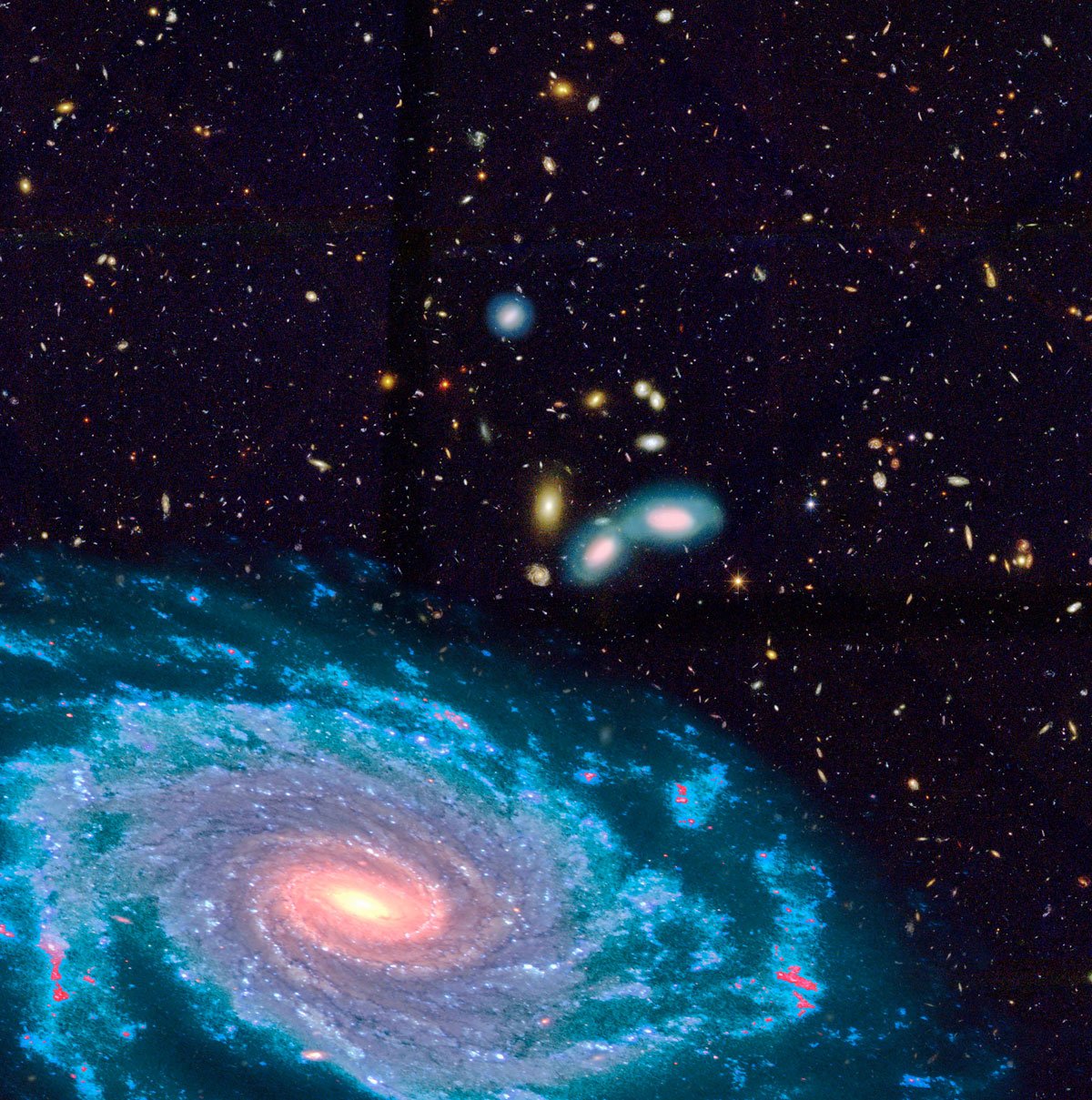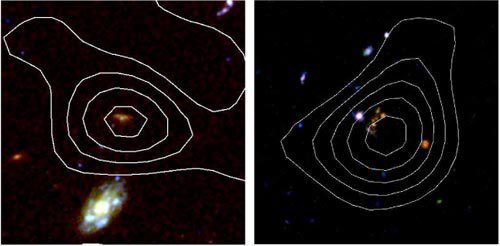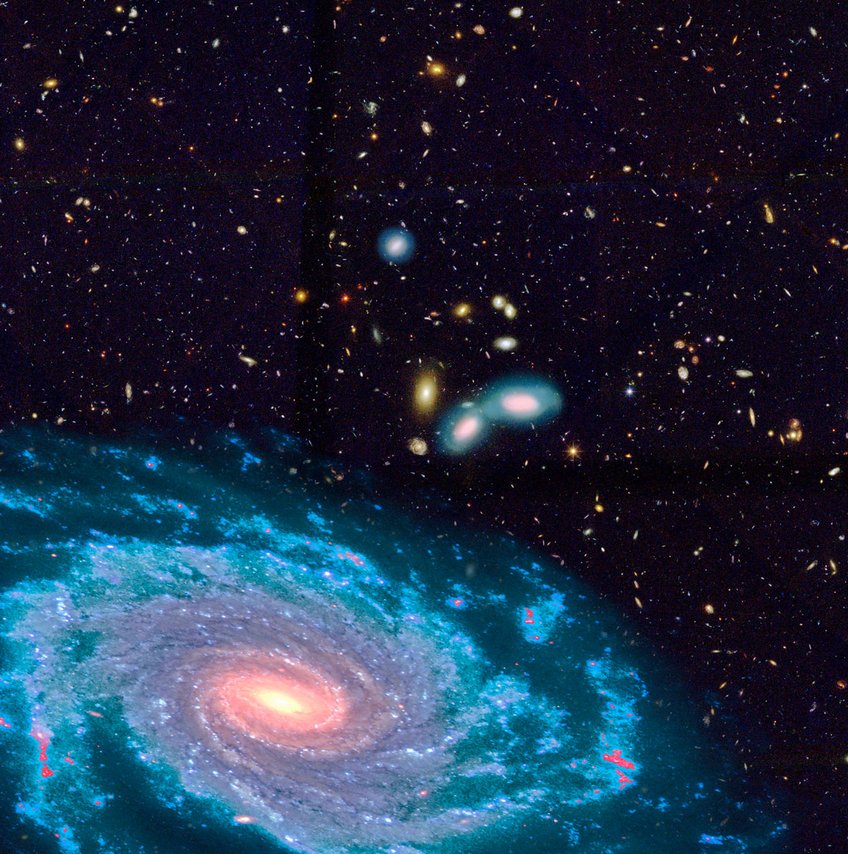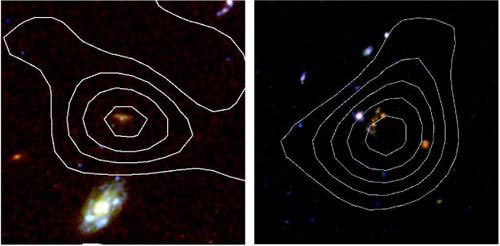Strong Galaxy-wide Star Formation in the Distant Universe
An international team of astronomers from France, Germany, the USA and India has observed for the first time the cool molecular gas in ordinary massive galaxies in the young, distant universe. The scientists discovered much more of it than being observed in galaxies in the local universe. This gas is the building material for stars still nowadays born in normal, undisturbed and not active galaxies in our local universe. The observations have been made with the millimeter interferometer located at the Plateau de Bure (France). The Institute for Radio Astronomy in the Millimeter regime (IRAM) in Grenoble is operating this telescope.
This finding indicates that massive galaxies built major fractions of their stars at lower rates and over longer timescales and not than thought before during explosive events being triggered through the collisions of two or more galaxies. This result opens new major possibilities for understanding galaxy formation in the young, distant universe shortly after the big bang.
In galaxies of our cosmological neighbourhood we are observing how star formation is currently going on. Here star formation is observed to take place in two fundamental modes. In more or less undisturbed, »ordinary« spiral galaxies – like our Milky Way – new stars are formed primarily in the spiral arms of the disk-like structure. These are the sites which contain most of the building material for star formation – molecular hydrogen gas. Currently, a few solar masses per year of newborn stars are produced in our Milky Way.
When spiral galaxies merge due to a close encounter, a more efficient process is observed in which stars are formed at much higher rates but at limited time scales up to a few hundred million years. During major galaxy collisions, the molecular gas is efficiently compressed toward the center of the merging system, reaching densities that are much higher than in spiral galaxies. This can enhance in the central regions the rate of star formation up to several hundred solar masses per year, or more, in these objects, which are thought to very rapidly consume their gas. Astronomers call the resulting galaxies Ultra-Luminous InfraRed Galaxies.
But what is the dominating mode of star formation in the young universe? As observations showed, collisions of galaxies in the distant Universe are thought to be much more common than nowadays due to the higher spatial density of galaxies (since then because of the cosmic expansion the galaxy density went gradually down); and even ordinary massive galaxies in the distant Universe were forming stars at prodigious rates. This provided widespread support to the idea that the predominant star formation mode in the distant Universe was the collisions-like, high efficient ULIRG-phase. Observations of molecular gas properties in distant galaxies, limited to the brightest and rarest systems (the ULIRGs), had so far confirmed this picture.
Using high sensitivity newly refurbished detectors for radio waves in the millimeter range at the Plateau de Bure Interferometer,* the authors of this here presented work have been able for the first time to measure the molecular gas content of ordinary and representative galaxies in the distant Universe. The team, including Helmut Dannerbauer from the Max-Planck-Institute for Astronomy in Heidelberg (Germany), observed two massive, disk-like galaxies which emitted their light 4.3 billion years after the big bang and succeeded in detecting both sources.
The findings of this project, described in a paper published in Astrophysical Journal Letters on January 20th 2008, have profound consequences for understanding the processes regulating massive galaxy formation in the distant Universe. Both galaxies are found to host giant gas reservoirs, but with a star formation mode that closely resembles the one observed in local spiral galaxies – a phenomenon observed here for the first time: The ordinary distant massive galaxies behave like scaled-up version of the Milky Way galaxy, with proportionally larger molecular gas reservoir and star formation activity, but with overall similar efficiency in forming stars.
This discovery is helping astronomers to shed light into the way galaxy gradually built up their stellar component. It suggests that mergers between galaxies are not the major channel for star formation in distant galaxies. The large gas reservoirs newly observed could maintain star formation in these galaxies over hundreds of million years, ten times longer than in the extreme sources that were known before, implying that a large fraction of the stars in massive galaxies is formed relatively slowly. These observations also help to explain the clumpy-like appearance of distant galaxies, because the large gas reservoirs are prone to fragmentation due to gravitational instabilities.
These new observations have also shown that »ordinary« galaxies in the distant Universe, 10-100 times more common than the extreme sources (e.g. the ULIRGs) so far studied, are now within reach of direct observations of their molecular gas content with current.
Original publication:
Emanuele Daddi(1), Helmut Dannerbauer(2), David Elbaz(1), Mark Dickinson(3), Glenn Morrison(4,5), Daniel Stern(6), S. Ravindranath(7),
Vigorous Star Formation with low Efficiency in Massive Disk Galaxies at z = 1.5,
The Astrophysical Journal Letters, January 20th, 2008.
- Service d’Astrophysique, CEA Saclay, Orme des Merisiers, 91191 Gif-sur-Yvette Cedex, France
- MPIA, Königstuhl 17, D-69117 Heidelberg, Germany
- NOAO, 950 N. Cherry Ave., Tucson, AZ, 85719
- Institute for Astronomy, University of Hawaii, Honolulu, HI 96822, USA
- Canada-France-Hawaii Telescope, Kamuela, HI, 96743, USA
- Jet Propulsion Laboratory, Caltech, Pasadena, CA 91109
- IUCAA, Pune University Campus, Pune 411007, Maharashtra, India
* The Plateau de Bure Interferometer is managed by IRAM. IRAM is supported by the Max-Planck-Society, INSU/CNRS (France), and IGN (Spain).



